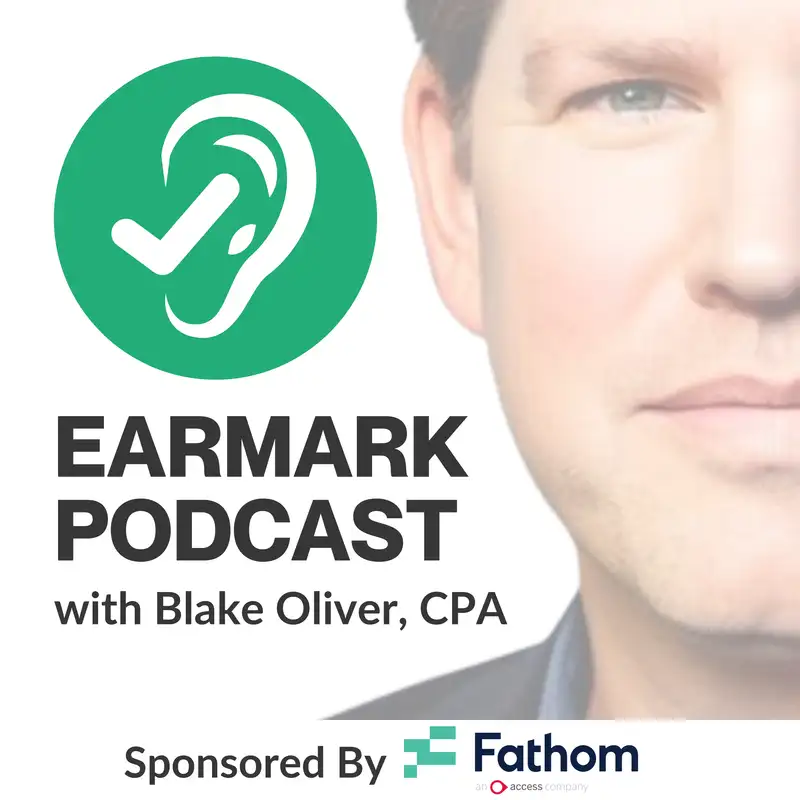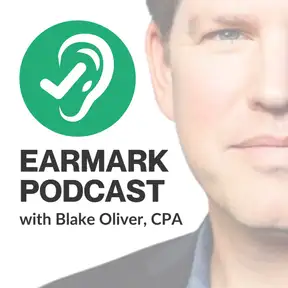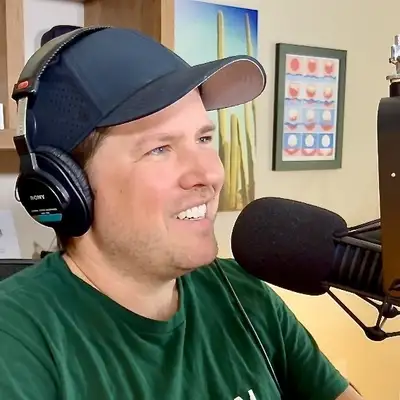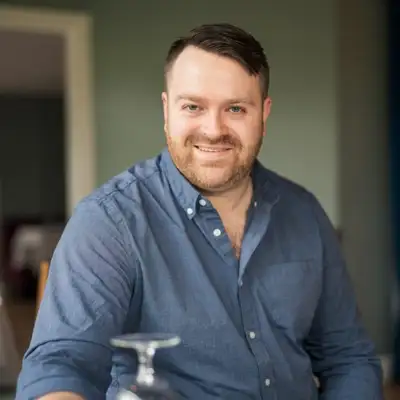The Future of Advisory: Unlocking Your Firm’s CFO Potential
Download MP3There may be errors in spelling, grammar, and accuracy in this machine-generated transcript.
Chris Macksey: The darkest times for an industry are the time in which an accountant is most valuable.
Blake Oliver: Are you an accountant with a continuing education requirement? You can earn free Nasba approved CPE for listening to this episode. Just visit earmarked app in your web browser, take a short quiz and get your certificate.
Blake Oliver: Welcome to the earmark podcast. I'm Blake Oliver, coming to you from Boston on the advisory Amplified tour recording in front of a live audience [00:00:30] at Ned Devine's. Today we are talking about the future of advisory, how firms unlock CFO level services and become true strategic partners. Going beyond reports to real guidance and insight. I'm joined by James Irving, Head of Sales, Americas at Fathom. Welcome. Welcome, James.
James Erving: Thanks. Thanks for having me.
Blake Oliver: And we've also got Chris Maxey, CEO of Prefix Accounting.
Chris Macksey: Hey, how are [00:01:00] you doing?
Blake Oliver: Did I say that right?
Chris Macksey: You did.
Blake Oliver: I am not a foodie. So when I see that on a menu, sometimes I, uh, like, is it pricks fix? Definitely not. Right.
Chris Macksey: You're just thinking about it too hard. Prefix. Prefix. There you go. You're good, you're good. You don't need to get fancy.
Blake Oliver: Well, tell me then. Why. Why is your firm named after a term that I would find at a fine dining establishment?
Chris Macksey: So, shockingly, uh, we work with restaurants. Uh, so [00:01:30] we, uh, our focus is entirely on the hospitality industry. Uh, so we work with, uh, independent restaurants, uh, some lodging clients and some food based retail. Uh, and we only work with them. And so marketing to our to our niche, uh, by calling it prefix. And, uh, our service model is that we set the menu much like you would, uh, the chef would at a, at a restaurant. So, uh, the tech stack is [00:02:00] there really aren't any options. You're leaving it up to the chef. We're choosing what the tech stack is. There's only one price point its prefix. And you're just going to have to enjoy the ride.
Blake Oliver: I love that. So why does that matter to you? You deliver a lot of advisory services in your firm. Tell us about that. Like what? What? Where are you at with advisory?
Chris Macksey: So we do right now, like the service interval [00:02:30] is that we will meet with our clients on a monthly basis. We'll have an advisory call with them, uh, walk through their numbers. Uh, but beyond that, we double down and really focus on our, our our, our niche. And so, um, I'm, I'm, I'm a cook that, uh, studied economics and so in college. So I kind of look at things from that lens. And so, uh, we pay a lot of attention to what the trends are in the restaurant [00:03:00] industry. What's what, what's popping off, uh, in during Covid, there was a big thing with champagne and caviar for some reason. Uh, and what's coming up, what is, uh, what is going to be a fad? What is going to be a trend? And then what the macroeconomic conditions of the state of the economy is, and how that's going to affect, uh, restaurants, because, uh, when the economy isn't as good, one of the first industries that's really, truly affected [00:03:30] is, is the restaurant and hospitality industry.
Blake Oliver: So how do you weave that knowledge of the restaurant industry into the the advisory services that you're delivering, the meetings that you're having with clients?
Chris Macksey: A lot of it is, uh, we break up the time so that, you know, we're talking about the business itself, looking at what, what's happening, uh, specifically to them, but then kind of zooming out and looking at, like, what the longer term goals are. And so we're But [00:04:00] restaurants are rarely are finite, right? Like they're changing all the time. They're changing the business model, how they're operating. And as they're thinking about what they're doing there, we're trying to guide them into making the right choices for what the economic conditions are. So, for instance, like right now, consumers really feel a lot of pain in the pocketbook. Uh, and so your, uh, you know, auto loan default rate is up. [00:04:30] Uh, credit card balances among consumers are at its highest levels. Consumer confidence is down. And so if you're thinking about opening a restaurant or you're thinking about changing your restaurant, a fine dining concept with $175 prix fixe menu is probably not going to go so well right now. So we try to we try to weave that into the conversation and have people thinking about that long term as, as they're running their business.
Blake Oliver: So [00:05:00] based on what is happening in the economy more broadly, you can advise clients as to what what menu items to offer or what how to expand or where or why not to or any of those things.
Chris Macksey: Yeah, exactly. Like, you know, timing is everything with any business. And it's even it's definitely the case for a restaurant. You know, they're they're dumping half 1 million to $2 million into a concept. And if you make the wrong bet, like, that's [00:05:30] it. So making sure our clients, you know, we came out of 20, 24, uh, out of Covid, uh, and restaurants were feeling a little bit better and thinking about like what another concept might be. Um, and a lot of those, a lot of what you decided is really hurting you right now based off of those conditions. Uh, so, like, right now we're talking quite a bit about [00:06:00] value based menus like, uh. What? Affordable menus are there. Like what? What people can, uh, you know, feed their family of four for, you know, under 75 bucks. Under 50 bucks, uh, is really is kind of what a lot of the, a lot of folks are talking about right now.
Blake Oliver: So did you start with advisory first in your firm? Were you always doing advisory work?
Chris Macksey: Yes. It's, uh, with advisory [00:06:30] is required at our firm. So, like, if you're if you're working with us, you have to do the advisory, because that's the thing that kind of makes it sticky. You know, otherwise if it's just the bookkeeping, if it's just the payroll, it's it's a commodity, right? And so if you're not giving them that advice, then they can go somewhere else. They can go somewhere cheaper. They can go to any old generalist firm and get the same thing.
Blake Oliver: I want to come back and dig in more to how you do advisory at your firm. For [00:07:00] now, though, let's turn to James. James, you have a broad view across hundreds of firms that are doing all different types of advisory services. And I think one of the biggest challenges is for a firm that doesn't do it right now. You want to do it and you have all these clients, and it's not clear just how or what to do or even who to serve. So do you have some indicators that you can point firms [00:07:30] to look at, like how would I know? How could I get started, I guess is my question.
James Erving: Yeah, I think I think there's a couple angles on that. One is, you know, who's the who's the client for the service and then the service itself. You know, there's identifying who, um, out of your client base would be a good fit for advisory services. And I think it comes down to, you know, several factors. It could be the speed of their growth that they're going so quickly that they just need that additional, um, [00:08:00] Um, hand-holding or help? It could be the size they're at. Um, managing their their, uh, their finances have become challenging for them to DIY, and they just need that additional help, but not too big that they have a CFO in house or they, you know, they have that, um, that expert in-house, um, could be around an event, uh, you know, um, exit planning, uh, acquisition, acquiring, growing and growing their business. So those are, those are [00:08:30] some of the trigger points probably for that type of service. Um, and then how to get started, I think, you know, for a firm that's not doing it yet, we see, uh, forecasting be a great first step. Um, if firms are not doing that yet or they're not, uh, charging for it, maybe it's a random act of advisory. Um, they're, uh, you know, the forecast becomes a great place to start because it's driving that decision making and bringing clarity to the to the future. [00:09:00]
Blake Oliver: I love that phrase random active advisory. I think, uh, we've all been guilty of that. I mean, we we may not be attaching a value to it, and we may not be selling it, but we're all we all do it to some extent. So tell me more about forecasting. What is that MVP look like? What is the minimum viable product for forecasting for a firm that hasn't done it?
James Erving: Yeah, it's a great question. I think um, [00:09:30] forecasting is pretty broad too. I mean, as, as probably a lot of, you know, like there's, um, there's a short term cash flow forecast which is really driven, you know, off of the, the transaction base and can tell you what's my cash going to be in in a week or two weeks. And that's probably where most small businesses are going to want to start is, you know, because it's at that survival layer. Um, the step up from that I would say, is more of the, the planning, more of the, um, fpna piece. [00:10:00] And that's typically, you know, more of a forecast that's driven off of the financials that has, you know, closed books behind it. And it has more of a long term view in mind. And so that's going to give you more of that I would say like 3 to 12 month and beyond. Um picture. And then you can also layer on the business plans above the baseline, you know with that. So building that baseline building scenarios and then being able to run scenarios and events quickly [00:10:30] on the fly. Um, maybe on a meeting or, you know, after a conversation with clients.
Blake Oliver: And who in my firm can do this? Does it have to be me? You know, does it have to be a partner?
James Erving: That's a good question. I would say it probably depends on your staff and training level. Right. Um, and comfortability. But there are tools out there that can help with it. Now, you know, you don't have to build an entire Excel model customized to a client to, to get started with it.
Blake Oliver: Well, I'll turn that question [00:11:00] to you, Chris, who does the do you do forecasting and you know.
Chris Macksey: Who does it?
Blake Oliver: Who does it? Well, let's start with do you do forecasting and if so, what what kind.
Chris Macksey: We don't do cash flow forecasting. Uh, just because from restaurants have such tight cash flow that like.
Blake Oliver: There's no point.
Chris Macksey: Yeah. You're off 5%. And that just like your cash flow projections shot up. So we we generally [00:11:30] will do like we'll do a budget for them for that for, for a year out. Uh, and then we'll look at what we think the market's going to bear for that and then look at what their past numbers are and then kind of make a decision based off of that. But for for really cash flow type businesses it's pretty difficult. Um, as far as who does it um, we do have.
Blake Oliver: Well, so [00:12:00] before you do that. So what is the what is the forecasting that you're doing? It's mainly budgeting mainly just. Okay. So but that's a forecast right. So you're creating a budget. Yeah. Who does that.
Chris Macksey: So our director of advisory uh does a lot of that. But they also we also try to involve the accountant on it so that they get a little bit of experience, like thinking about that from a, uh, less of a is more of a proactive thought rather [00:12:30] than only looking at the historical, um, and, uh, I think a lot of, uh, accountants maybe think that that's, uh, kind of a scary thing to do. But once they actually do it for the first time, they realize, oh, I'm just looking at the last three years. I'm kind of rolling it forward, making an educated guess on what it's going to be. And that's really all it is. Um, so it's I think it's a good opportunity for, uh, accountants to be able to kind of step up to the next role, and it's. Yeah.
Blake Oliver: And [00:13:00] what is the deliverable of that?
Chris Macksey: So the deliverable is we will meet with them. Look at that. Look at that budget for the year. Talk about it. Um, because they may have some insight to the local economy that might be that our, our historical basis might not have picked up on like, uh, you know, uh, in urban environments, there might be construction on that street. And so next year's not looking so hot. And so, [00:13:30] uh, we'll talk about that before finalizing kind of work through those numbers. Uh, and then from there we'll do budget versus actuals. And QBO.
Blake Oliver: James, what is the biggest misconception of, uh, advisory services?
James Erving: Honestly, I think, uh, there's still confusion about what it is in the first place. And, um, maybe a lack of definition in the industry about what what's [00:14:00] being talked about when when we're talking about advisory. Um, so I think that's the first point of confusion is just what's what's the like you asked what's the deliverable like? What are we actually talking about doing here?
Blake Oliver: Well, first let's define it. What is it? What does it mean? What is it to you or Chris? Do you want to take that? If you had to define advisory services. You gave me a look like. Sorry to put you on the spot here.
Chris Macksey: Uh, I really it's it's any of the work that, like, you can't scope really [00:14:30] very easily and it's it it's not cas in accounting in my case. Um.
Blake Oliver: And so you consider it separate? Yeah, totally separate from that. And, and you do that on top of it.
Chris Macksey: Yes.
James Erving: Because they get lumped together. Cas and advisory tend to like get.
Blake Oliver: Yes. Well, the AICPA did us a big favor by calling it client accounting and advisory services. So that's interesting that you think of it as separate. So [00:15:00] as you have your client accounting services or your what do you call it in your firm? Is that what you call it, Cass? Yeah. And then advisory is it's own thing. Is it done by a different team?
Chris Macksey: Yep. Different person.
Blake Oliver: Different person. Okay. Interesting. James, is that what you see, or is it mixed up?
James Erving: Yeah. I mean, you know, I default to Chris on this, but, like, what I think of it is like, really being involved in the decision making process rather than just the delivery of information.
Blake Oliver: Say that again.
James Erving: So instead of just delivering information, which is, you know, the Cass output is [00:15:30] actually being integral to the decision making in the business. That's how I would define it.
Blake Oliver: I've heard it defined as, uh, having an opinion. Right. And to be involved in the decision making, you have to have an opinion. Yeah. And I have run into so many accountants who just won't have an opinion about anything other than the accuracy of the financial statements.
Chris Macksey: Yeah, that's very true. It's I mean it you look at the historical right and [00:16:00] you develop an opinion based off of like what? Like for instance, our case like food cost is is trickling up. Is it that some something's changed in the kitchen or is it just inflation that's causing that number to gradually rise over time? Um, and it's a it's an opinion.
Blake Oliver: You're you're going beyond just, uh, what has happened and asking the question, why is it happening and what will happen in the future, given that so [00:16:30] what is the, uh, deliverable look like, James? Um, in, in like, let's talk about, like, what is the ideal forecast?
James Erving: Yeah. I mean, in terms of of fathom, um, you know, what the typical output that a firm is, is delivering is a, um, you know, probably a 3 to 12 month cash flow forecast, but that's a three way. So it's, it's it's forecasting the profit and loss, the balance sheet and the cash flow statement.
Blake Oliver: And you're also producing [00:17:00] the, uh, I mean, you're producing the typical financial statements, the historical ones. Correct. And then you're adding on the correct.
James Erving: Yeah. Yep. Um, so then you're adding on the forecast and then reporting every month against that forecast, um, variance uh, as well as the budget. Okay.
Blake Oliver: Anything else in there? I mean, that's that's basically the core of, uh, of a forecast. Anything you would add, Chris, to like a that kind of package?
Chris Macksey: Not to the not to the forecast. No.
Blake Oliver: Um, [00:17:30] any other like, advisory deliverables you see firms providing.
Chris Macksey: We usually are doing a lot of metrics. Uh, our client base is largely visual people. And, uh, the financial literacy is usually pretty low. Like most, like, in my case, like, I cook for like ten, 15 years, I didn't see a PNL until, like, I started doing accounting. Um, and so. Putting [00:18:00] it into visual terms is a really helpful, useful aid to like having them start to understand the financials. So we look at like what your food cost is, what your labor costs are. Uh, we, uh, start the narrative of like understanding what the difference is between, like, your bottom line, your net income and what cash flow is because no non, no non accountant understands what the difference is. And so we try to put all of those things into visual form [00:18:30] so that there's they can keep seeing it over and over again and slowly start to digest it.
James Erving: Yeah I was just going to add on to that and say you know the the metrics are so critical. Um, we see, you know, financial ratios that are, um, customized to that industry. Right. Um, so labor costs as a percentage of sales, you know, sizing everything to revenue to be able to then compare across, uh, clients for firms is really powerful. Um, [00:19:00] and, you know, like Chris working with restaurants has a a really high quality data set to work off of and firms also you know that the that the data is sound you've done you've done the book. So it's the highest quality comparison you could make. And then being able to aggregate all that data, make comparisons and benchmark basically within your clients and then to the industry to understand the difference. There's pretty pretty common firm firms that [00:19:30] are specializing in industries.
Chris Macksey: Yeah, that's that's a really good point because like right now it's uh, terrible environment for restaurants. It's been, you know, uh, at best it's 0% over last year. At worst it's like 20% down. And I think that a lot of business owners in environments like this are are sitting there going, is it is it me? Like, am I doing something wrong that's causing my business to tank like that? And [00:20:00] when you can actually see like that data and see it for yourself and validate it for yourself. You know that. No, it's not you. It's it's it's just the economy.
Blake Oliver: And is that due to rising food costs, inflation in that regard people spending less a combination.
Chris Macksey: It's people's fear of the economy right now and not wanting to spend. You know, people's pocketbooks are feeling tighter and tighter. And, you know, the first thing that goes when you're, uh, [00:20:30] you don't feel like you have a lot of money in the bank account is you don't eat out as much and you don't you don't travel as much. So it's always been kind of a leading indicator for how the economy is doing, is how the restaurant industry is doing.
Blake Oliver: Do you ever regret concentrating your business in a single industry?
Chris Macksey: Covid was an interesting time for me. Um, I, I don't I think the [00:21:00] times in which the darkest times for an industry are the time in which an accountant is most valuable. We had a lot of we actually had a lot of growth during Covid, because a lot of accountants or a lot of restaurant owners couldn't get their, um, accountant to help them with their PPP loans or their idols or their irtk. And, and so we, we were able to help a lot of people with [00:21:30] that. And it was okay for us. It was great. It was like all this gray showed up because of that. But, um, it, it and this year, I think is a lot like that, too, where we're starting to see a lot of people come to us because they're not getting the advice and they're feeling really nervous about their business right now.
Blake Oliver: So going back to that metrics, uh, idea giving, giving clients these metrics that are not part of the traditional financial statements. What does that look [00:22:00] like? Is this a document that is prepared for them? Is this part of the financial statements? Is this like how do you how do you show these metrics?
Chris Macksey: So the one that I like doing is I love doing like a 12 month look back on like a set of metrics. So like we'll use food cost and we'll say let's look at what the last 12 months looked like. Let's look at what the last year before that looked like and then what the rolling aggregate is. So like you can see like what is happening like some months it'll kind of bounce all over the [00:22:30] place. But like you can see what it is on the aggregate and get an idea of like what the trend is.
Blake Oliver: That's such a good point because a lot of times I see metrics presented just as here's the number for the month, no comparison. And it's kind of useless without that. Yeah. So you're doing trailing 12 months.
Chris Macksey: Yeah.
Blake Oliver: All your metrics.
Chris Macksey: Yeah. I mean if your food cost was 28% this month, uh, that's good for like a restaurant. But if it was 23% the last 12 months, like something bad's happened. [00:23:00]
James Erving: Yeah. You also need to have that. I mean for restaurants, other similar businesses there's seasonality often. Right. And so being able to have that year on year comparison is critical to I would imagine.
Chris Macksey: Mhm.
Blake Oliver: What about like non-financial metrics. What do you track.
Chris Macksey: Uh for us like our lodging clients are are big on that. Um they have a lot and they're kind of very like demand based. So like, you have, like your number of rooms sold, [00:23:30] your ADR, your occupancy rates, like, all of those numbers are not something that you will see surfaced in QBO, uh, or in fathom, uh, pulled from QBO. But, uh, we use a lot of them. Uh, it's probably one of my favorite features of fathom is to be able to incorporate them and then also use the formula to be able to, like, apply it to like revenue and cost numbers.
Blake Oliver: Right. Create that KPI and then and show it every month and [00:24:00] what you can I haven't seen fathom in a while. I was a I was a customer in my days. Uh, and I remember you could like. It was very beautiful, the way you could see which which KPIs were up and which were down.
James Erving: Yeah. We try to have visuals around everything, but, um, but having, um, all your custom KPIs, having the target that you've set for the client, um, based on benchmark or based on, you know, variation on a client [00:24:30] basis and then having that indicator. Yeah.
Blake Oliver: I feel like just bringing in operational metrics and reporting on those over time is such a huge value add and would really differentiate any firm from one that's just producing a PNL and a balance sheet in the statement of cash flows.
Chris Macksey: Yeah. Yeah. The more operational metrics that you can bring into it, the deeper the data is. You know, if if your revenue is going down. Right. Like the last couple of years. Right. Inflation we've [00:25:00] had Going up. Revenue has been fairly flat. That doesn't mean that business is flat. That just means that there's less people and they're paying a little bit more. But like, there are less asses in seats, like there's not as much business going on. And you might not have seen that if you didn't bring that information into the into fathom.
Blake Oliver: All right. So take us out. Um, it's tough to get started, James. Do you have one piece [00:25:30] of advice for a firm that is looking to get started in advisory? Where should they begin?
James Erving: I mean, I think it's been said today, you know, from an approach, um, asking a lot of questions and just really being curious about, uh, your client's business. I think it's I mean, Chris may may be an expert on restaurants, but it's hard for someone to be an expert on somebody else's business. Right? So you're [00:26:00] you're always going to know less than them, but just being comfortable asking questions to really dig in and discover what you need to know and then to get started. Um, you know, there's great tools out there to, to help with the deliverable side.
Chris Macksey: Um, really.
James Erving: Someone. Yeah, there are tools.
Blake Oliver: Um, don't do it in Excel, is what we're saying.
James Erving: Yeah, yeah. Be efficient with with your time. Um, yeah.
Blake Oliver: And, uh, Chris, I take it your answer is going to be go work for 10 to 15 years as a chef. [00:26:30] And then and then you're ready, I actually. How much did that help you? A lot.
Chris Macksey: A lot, yeah. Like it like, it's a little bit of a cult industry and that like if you're in, you're in. If you're out, you're out. Uh, so it helps a lot specifically with that.
Blake Oliver: So is it really like the bare.
Chris Macksey: There's a little bit of trauma there. Yeah. Yeah.
Blake Oliver: Great show if you haven't seen it.
Chris Macksey: Uh but I would say like I would [00:27:00] I would try to find something that you're passionate about? I would say, like, try to narrow down the industries that you're looking at and then spend more time looking at that industry as a whole rather than trying to do everything really well. Try to do a couple of things. Well, I mean, that's how our firm started. We started as a as a generalist firm and we we niched down. And so thinking about like what those businesses that [00:27:30] like actually like get you really excited and like really make you think about things. I would start there and see how you can be helpful.
Blake Oliver: I think that's a great way to wrap this. Uh, Chris James, thanks so much for sharing your expertise here on the podcast. And, uh, let's give him a hand.
James Erving: Thanks for having us on.
Chris Macksey: Always a pleasure.




